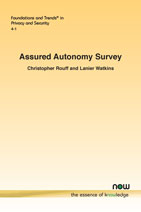Assured Autonomy Survey
By Christopher Rouff, Johns Hopkins University Applied Physics Laboratory, USA, christopher.rouff@jhuapl.edu | Lanier Watkins, Johns Hopkins University Applied Physics Laboratory, USA, lanier.watkins@jhuapl.edu
Abstract
Autonomous robots and other systems are no longer just subjects of science fiction, but are becoming common occurrences in our everyday lives. Autonomous vacuum cleaners, lawnmowers, and other household helpers are starting to be common place, with autonomous cars now being tested around the world and autonomous drones starting to be used to deliver packages and groceries. Though they will soon be common occurrences in everyday life, assuring their safety, privacy and security is still a huge challenge. A number of autonomous car accidents have occurred after millions of miles of testing, as well as other injuries from other types of autonomous systems. Assuring the proper behavior and safety of autonomous systems is an important endeavor to reduce risks in using them. This monograph discusses assurance for autonomous systems, the different approaches to assuring autonomy, formal analysis, cybersecurity, certification and research challenges.
Assured Autonomy Survey
Autonomous systems will soon be ubiquitous in our society, saving us time, performing tasks we do not want to do, caring for us and keeping us safe. Autonomous robots in homes and businesses are already cleaning floors, mowing lawns, delivering meals and packages, and the technology is now driving cars and trucks. Though they will soon be common occurrences in everyday life, assuring their safety, privacy and security is still a huge challenge. A number of autonomous car accidents have occurred after millions of miles of testing, and injuries regularly occur from other types of autonomous systems. Assuring the proper behavior and safety of autonomous systems is an important endeavor to reduce risks in using them. This monograph discusses assurance for autonomous systems, the different approaches to assuring autonomy, formal analysis, cybersecurity, certification and research challenges.
The monograph starts with a brief introduction to assured autonomy, providing definitions and key terms. Thereafter, an overview of assured autonomy and different aspects of system and software assurances are provided, and Section 3 discusses governance, trust, ethics and privacy of autonomous systems. Section 4 covers assuring the correct operation of autonomous systems, which can be done through techniques such as formal verification, testing and monitoring. The monograph then describes certification of current systems and proposals for certifying autonomous systems, providing an example of the certification of aircraft software and multiple proposals for how autonomous systems could be certified. Lastly, areas of research in assuring autonomous systems are covered.
